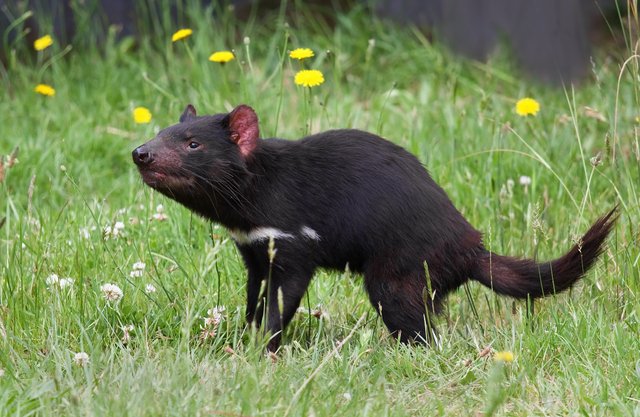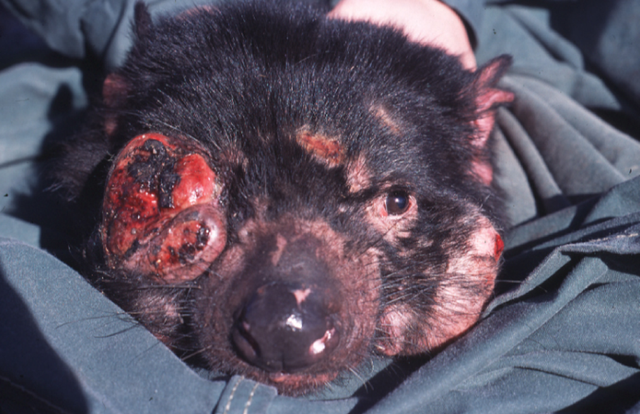A genetic mutation in Tasmanian devils (Sarcophilus harrisii) allows some individuals to survive the contagious cancer "Devil facial tumour disease"
The Tasmanian Devil (Sarcophilus harrisii) is a carnivorous marsupial that is endemic to the island Tasmania just south of Australia. It used to be found on mainland Australia as well, but it became locally extinct on the mainland about 3,000 years ago (Brown, 2006), although this date is hugely debated. Following the extinction of the thylacine / Tasmanian tiger, the Tasmanian Devil became the largest carnivorous marsupial, being about the same size as a small dog. The males can reach a body mass of 8kg, while females tend to be around 6kg. Both sexes have a black coat, with a small white patch on their fur.

A Tasmanian Devil. Photo by JJ Harrison, posted with CC BY-SA 3.0.
The devils are versatile animals, and are found in pretty much all the different habitats available on the island, even close to urban areas and cities. They spend the day in a dense bush or a hole, and spend the night to hunt by themselves. They are opportunistic eaters, and will eat anything they can get their hands on. Their prey can be as large as a kangaroo, but smaller animals like wombats are more commonly predated. They will not pass up a free meal, and they frequently eat carrion. This leads them to eating a lot of road kills, which again often lead to many devils being hit by cars themselves. This can actually be a big problem, and certain populations of Tasmanian devils have actually been severely reduced as a consequence of being killed by cars (Jones, 2000).
Even tough they are primarily solitary hunters, they won’t mind sharing a meal with other devils. They also partake in social activities, but scientists have not been able to determine the extent of their social lives at this point.
The Tasmanian devils are very interesting animals, but unfortunately they are currently facing extinction. The IUCN Red List has already put them in the category “Endangered” due to their declining numbers (Hawkings et al., 2008), and the reason is actually a bit different from what a lot of the other endangered species are facing; they are being eradicated by a contagious type of cancer (in addition to suffering from human encounters, losing their habitat etc).
How a contagious cancer is threatening the Tasmanian Devil with extinction
The first cases of facial tumors began in 1996, and it soon became clear that these cancer tumors killed nearly all of the individuals who got them. This type of cancer got named Devil facial tumor disease (DFTD), and it has hit the population extremely hard. As the disease progresses, the devils get huge, visible tumors that cover their face. Once this tumor grows big, it will destroy the underlying bone of the jaw, which will prevent the devil from being able to eat. This could lead to it starving to death, unless the cancer is able to kill from other means first, such as organ failure.
As you would expect, the cancer has evolved while going from one host to another, and over 100,000 devils had been infected and killed by 2012 (Deakin & Below, 2012). Transmission occurs mainly from sexual contact, where the devils will bite each other and spread the disease. Some models predict that the disease itself could lead to the entire species going extinct, but leading researchers believe that there insufficient data to say anything for certain (McCallum et al., 2007). What we do know for sure is that around 95 % of the original population has been wiped out, and populations that get the disease tend to go locally extinct pretty fast.

The tumors themselves are not very pleasant to look at. This one has one of its eyes covered with a tumor. Photo by Menna Jones, posted with the CC BY 2.5 license.
Not a strict 100 % mortality
Scientists used to believe that the cancer has a 100 % mortality rate upon infection, but about a year ago three Tasmanian devil researchers noticed something extraordinary when trapping and tagging devils as part of a research project. What they found was that a very small percentage of the devils survived the cancer, and the tumors gradually went away on their own, over a period of several months. This tumor regression is rare in all types of cancer, but it does happen from time to time.
Seeing as some of the animals survived, it became obvious that the mortality rate was indeed lower than 100 %, and of course the research team became interested in learning the mechanism that allowed these individuals to survive. The team collected genetic samples from the seven different devils that had survived the infection and did a whole genome sequence of their DNA. To have something to test it against, they also collected and sequenced the genetic material from three devils that died from the tumors, and otherwise showed no sign of tumor regression.
When the results were in, they found remarkable differences between the tumor regression group and the control group. The devils that showed tumor regression had lots of differences compared to the control group in a genomic region that is known to be related to immune response and cancer risk in both humans and other mammals. While they can’t conclude that this is the reason why these animals showed a tumor regression, it seems to be highly likely.
The research has recently been published in the journal Genome Biology and Evolution by Mark J. Margres and 11 other different authors (2018). The research team will continue to work with the material, and hopefully they will be able to learn exactly which genes that are responsible for the tumor regression.
Is there a potential for human implications?
New cancer research in any mammal can potentially lead to improvements in human cancer research, but even if it turns out to be useful for that purpose, any results from this is far away. Still, spontaneous cancer regression combined with genetic therapy might be important in the future once we have better understanding of how to cure cancer, and for all we know the genes of the Tasmanian devil might be a part of a solution.
Even using this knowledge to save the devils themselves seem unlikely at this point, but it's great to know that there are some individuals out there that are naturally resistant to the disease that has wiped out most of the population. Maybe these few individuals will act as a genetic refugee for the entire species? I hope it won't come to that, but at least it now seems unlikely that the entire species will be killed by this single disease.
Sources
- Brown, O. (2006) Tasmanian devil (Sarcophilus harrisii) extinction on the Australian mainland in the mid-Holocene: multicausality and ENSO intensification, Alcheringa: An Australasian Journal of Palaeontology, 30:sup1, 49-57. http://doi.org/10.1080/03115510609506855
- Deakin, J. E., & Belov, K. (2012). A comparative genomics approach to understanding transmissible cancer in Tasmanian devils. Annual Review of Genomics and Human Genetics, 13, 207-222. https://doi.org/10.1146/annurev-genom-090711-163852
- Hawkins, C.E., McCallum, H., Mooney, N., Jones, M. & Holdsworth, M. 2008. Sarcophilus harrisii. The IUCN Red List of Threatened Species, 2008: e.T40540A10331066. http://dx.doi.org/10.2305/IUCN.UK.2008.RLTS.T40540A10331066.en. Downloaded on 05 December 2018.
- Jones, M. E. (2000) Road upgrade, road mortality and remedial measures: impacts on a population of eastern quolls and Tasmanian devils. Wildlife Research, 27, 289-296. https://doi.org/10.1071/WR98069
- Margres, M. J., Ruiz-Aravena, M., Hamede, R., Jones, M. E., Lawrance, M. F., Hendricks, S. A., Patton, A., Davis, B. W., Ostrander, E. A., McCallum, H., Hohenlohe, P. A., Storfer, A. (2018). The Genomic Basis of Tumor Regression in Tasmanian Devils (Sarcophilus harrisii), Genome Biology and Evolution, 10(11), 3012–3025. https://doi.org/10.1093/gbe/evy229
- McCallum, H., Tompkins, D. M., Jones, M., Lachish, S., Marvanek, S., Lazenby, B., & Hawkins, C. E. (2007). Distribution and impacts of Tasmanian devil facial tumor disease. EcoHealth, 4(3), 318. https://doi.org/10.1007/s10393-007-0118-0
Thanks for reading
Thanks for checking out my post about Tasmanian devils, the Devil facial tumour disease, and the new research about the tumor regression. I hope you enjoyed it, and please let me know if you have any constructive feedback.
Back to doing what you do best my friend! The part about this form of cancer being contagious is worrying though. Are there any human forms of cancer that are contagious?
Posted using Partiko Android
I'm glad you liked it, @gentmartin. Yes, this type of cancer can occur in humans, but it don't not really spread among us since we don't typically bite each other ;)
Thats my nights out in the Bangkok fetish clubs cancelled!
Posted using Partiko Android
Is that supposed to be a bad thing? :P
Good to see you writing these top-notch scientific articles again my friend! It is fascinating to see how fast an animal species can adapt and evolve to beat something as nasty as cancer to save it from extinction. These are amazing animals. I hope their population will grow. Thanks for sharing this post with us.
I'm happy to hear that you enjoyed the post, @phortun! And yeah, they are incredible animals, and I really hope we are able to save them. There are some good conservation programs going, so hopefully they won't go extinct from this cancer.
The title of this post is great: it explains the theme of the post and moreover it has a Little irony inside.
😁👍
Posted using Partiko Android
I'm glad you enjoyed the post, @moncia90!
Who knew that I would end my day feeling sorry for the Tasmanian devil?!?!
That was a great write up!
What can us ordinary Joes do to help?
Thanks! I'm glad you liked it.
That's a good question actually, and it depends a bit on where you live and what you would like to do. For citizens of Tasmania, driving more carefully during the twilight hours can actually help a lot, since it will reduce the chance of devils being killed by cars. They can also do some other stuff to make the lives of the devils more easy, like not using rodent poison, keep dogs on leashes etc.
As for everyone else, I think our best way of helping out could be to donate or volunteer for the Save the Tasmanian Devil Program (STDP).
Heck yes!
The problem and solution in one post!
Wonderful information about an animal that I know very little about. You presented this very nicely.
Thank you! I'm glad you liked the post :)
Your post is simply exquisite, so many details about the demon of Tasmania that is totally submerged in reading ... Who would think that we are humans and such a terrible cancer that would lead to this state criticized the possible extinction of this small animal.
Applause to your work.
The Tasmanian Cancer Demon is pleased with your reverence.

Thanks, I'm happy to hear that you liked my post. They are called Tasmanian devils by the way, not demons :P
I hit the size of a tumor, I did not know that the demons of Tasmania could give cancer. Great article.
I'm glad you liked it. And they are called Tasmanian devils, not demons by the way :)
This post has been voted on by the SteemSTEM curation team and voting trail in collaboration with @curie.
If you appreciate the work we are doing then consider voting both projects for witness by selecting stem.witness and curie!
For additional information please join us on the SteemSTEM discord and to get to know the rest of the community!
Hi @valth!
Your post was upvoted by @steem-ua, new Steem dApp, using UserAuthority for algorithmic post curation!
Your UA account score is currently 5.180 which ranks you at #861 across all Steem accounts.
Your rank has not changed in the last three days.
In our last Algorithmic Curation Round, consisting of 325 contributions, your post is ranked at #295.
Evaluation of your UA score:
Feel free to join our @steem-ua Discord server
That's the fascination of nature which I loves so much and one of the reasons why I can't believe just a Big Bang created all this.
Even if I would be an atheist I wouldn't be able to believe it's just a fluke when a genetic mutation saves these animals and makes it possible for them to survive the contagious cancer, that's simply wonderful. :)
Don't understand me wrong, of course I accept it when people have other opinions to this theme which I don't share, but that's my personally view on this and the reason why live-saving mechanisms in nature like this one are a confirmation for intelligent design in my opinion.